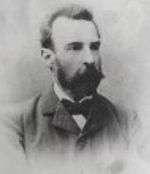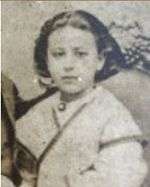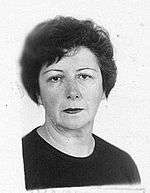Juan Manuel Canaveris
| Juan Manuel Canaveris Denis | |
|---|---|
| Personal details | |
| Born |
May 10, 1804 Buenos Aires, Viceroyalty of the Rio de la Plata |
| Died |
May 2, 1868 Buenos Aires, Argentina |
| Nationality |
|
| Political party | Partido Federal (lomo negro) |
| Occupation | Politician |
| Profession |
Legal Military |
Juan Manuel Canaveris (1804-1868) was an Argentine attorney, merchant, teacher and military officer. He participated of the escort of honor in the funerals of Manuel Dorrego.[1] And collaborated in the early days of government of Juan Manuel de Rosas.[2]
Biography

Canaveris was born in Buenos Aires, made his secondary studies in the National College. In 1819 is enlisted in the Argentine Army, and was retiring in 1821 as Ensign in the Húsares de Buenos Aires regiment.[3] Time later he was reincorporated and promoted to Captain.
In 1823, Canaveris devoted himself to teaching, serving as assistant in the Escuela de la Piedad (School of Piedad), in replacing Lucas Fernández. The Escuela de la Piedad was an educational establishments located in the neighborhood of San Nicolás.[4]
In 1831, Juan Manuel Canaveris Denis obtained a doctorate in law at the University of Buenos Aires.[5] Later, he served as procurator in the government of Rosas.[6] In 1833, Canaveris was appointed alternate member of the jury responsible to guarantee press freedom in the republic. The jury was composed of leading figures of the time as Juan Martín de Pueyrredón, Miguel de Azcuénaga, Tomás de Anchorena and José Canaveris (his father).[7]
Pursued by supporters of Rosas, Canaveris was forced into exile in Montevideo. In 1837 he traveled to Europe returning from Cadiz to Port of Montevideo on 28 December of the same year.[8] In 1839 he participates in meetings organized by Juan Bautista Alberdi and Valentín Alsina where was treated the problem of the French blockade of the Río de la Plata.[9] During the Great Siege of Montevideo, Canaveris served in the Fortaleza del Cerro. He was enlisted as soldado raso (private), a fact which caused him great pain because of his high social status.[10]
In Uruguay, Canaveris suffered persecution for his sympathy for the White Party. Interested in his situation Justo José de Urquiza sent a letter to Joaquín Suárez, who answered with a message addressed to Urquiza himself, expressing his total refusal to lend aid to Captain Canaveris.[11]
Juan Manuel Canaveris also was dedicated to trade and import, had a warehouse in the Catedral street 153 (now San Martín).[12] Canaveris had maintained business relations with the Hodgson & Robinson Co, importers from Manchester in Buenos Aires.[13] His business was located in the vicinity of the Faunch Hotel, an English establishment built in the neighborhood of San Nicolás. This place was known as "el barrio inglés", due to the large number of citizens of that nationality who inhabited the neighborhood.[14] In 1807, James Coyle had installed the first English tailoring of Buenos Aires.[15] In that neighborhood also worked the British financial institution known as Banco de Londres y Río de la Plata, established in Buenos Aires, around 1860.[16]
In 1826 Canaveris Denis was interested in acquiring hectares near the Salado River, in the current town of Bragado (Buenos Aires Province).[17]
As a lawyer he had taken part in the lawsuit against Antonio María Taboada, an Argentine politician who participated in the May Revolution of 1810.[18] After the trial against Taboada, Juan Manuel Canaveris wrote the book entitled Litis sobre un derecho de Tercería opuesto á la finca de propiedad de D. Antonio Maria Taboada, published in the printing press of J. A. Bernheim in 1856.[19]
Family



Juan Manuel was the third son of José Canaveris and Agustina Denis, possible descendant of Anton Denis, native of Limerick.[20] He was brother of Feliciano Canaveris assassinated by order of Manuel Oribe during the Civil War.[21]
Juan Manuel Canaveris married on August 21, 1842 in The Parish Church of St. Francis of Assisi, with María del Carmen Gutiérrez, born in Montevideo, daughter of Juan Gutiérrez and Lorenza Moxica, belonging to an Uruguayan family of Spanish origin.[22]
Canaveris and his wife were the parents of Sara Emilia, married to Miguel Bustos, Ángel, Juana, Haydeé, Elia Canaveris (wife Agustin Bayá, co-founder of Bolsa de Comercio),[23] Samuel Gerardo and Carmen Francisca. His son Samuel Canaveris was attorney,[24] and one of the first employees of the Casa de Moneda de la República Argentina.[25]
Manuel Canaveris and his wife made frequent trips to Genoa, where his son Ángel Canaveris (doctor of psychiatry) was born in 1847.[26][27] After being received at the University of Buenos Aires, Ángel Canaveris Gutiérrez was settled in Montevideo in the year 1873.[28] He was married to Paz Costa, being the parents of Ángel Canaveris Costa, a distinguished Uruguayan politician.[29]
Haydeé Canaveris Gutiérrez was married to Pedro Vicente Acevedo Echeverría, grandson (maternal line) of Vicente Anastasio Echevarría. She and her husband lived for a time in the city of Pergamino, birthplace of Pedro Acevedo.[30]
Gerardo Samuel Canaveris Gutiérrez was baptized with that name for being born on September 24, the feast day of St. Gerard.[31] He was married to Alina Fornaguera Portela, daughter of Dolores Portela and Rufino Fornaguera,[32] son of the Cnel. José Fornaguera,[33] and vice-president of the municipal committee of Quilmes, presided by Juan Clark in 1855.[34] Samuel did his elementary studies at Seminario Anglo-Argentino of Caballito, and enrolled at the University of Buenos Aires in 1869.[35]
In 1895, Samuel Canaveris was neighbor of his relative Héctor Canaveri, being both settlers in the Cuartel 01 of Quilmes,[36] populated at that time by a small community of Englishmen, who were established in the area since the 1830s.[37] The founder of this family (Canaveri) had been Juan de Canaveris, landowner in Quilmes around 1810.[38]
Around 1900, Samuel Canaveris settled in the Patagonia where he was a member of the Deliberative Council of Río Gallegos, Santa Cruz.[39] His family was linked to the Máximo Gowland, who were reservists in Cura Malal, Coronel Suárez (Buenos Aires Province).[40]
Carlos Manuel Canaveris Fornaguera was student in the Escuela de Maquinistas Navales (School of Naval Engineers) directed by Carlos B. Massot, a Captain of fragata, who served as Consul of the Argentine Republic at Newport, Wales.[41] He carried out an improvement course in Barrow-in-Furness, (United Kingdom).[42]
Canaveris and Carmen Gutiérrez were the grandparents of Sara Bustos Canaveris, married to Enrique E. Yateman, son of Enrique Yateman Collins and Edelmira Carranza, descendant of Juan José Viamonte (governor of the Province of Buenos Aires on two occasions).
Through his maternal grandmother María Prudencia Silva,[43] daughter of Antonio de Silva and Francisca de Merlo,[44] Juan Manuel Canaveris was descendant of Francisco Alejandro de Merlo de Lafuente, a Captain who served in the Fort of Buenos Aires, related to the family of Francisco López Osornio.[45]
Juan Manuel Canaveris died at the age of 64 on May 2, 1868, being witnesses Emilio Achinelly (his relative) and Tomás Quincke (of German origin).[46] He had lived until the day of his death in the same block[47] that his grandfather Juan de Canaveris.[48]
References
- ↑ El Lucero, diario político, literario y mercantil (1829–1833). (PDF), Imprenta Argentina (Acervo Digital)
- ↑ Columbus: Amerikanische Miscellen - Volumen2. Karl Nicolaus Röding.
- ↑ Tomas de razón de despachos militares, cédulas de premio, retiros, empleos civiles y eclesiásticos, donativos, etc., 1740 a 1821. Archivo General de la Nación (Argentina).
- ↑ Acuerdos del extinguido Cabildo de Buenos Aires, Volume 9; Volume 47. Buenos Aires.
- ↑ Revista de la Universidad de Buenos Aires, Volumen 44. Universidad de Buenos Aires.
- ↑ Amalia ; novela histórica americana. José Mármol. 1930.
- ↑ Registro Oficial - Volumen12. Buenos Aires (Argentina : Province). 1833.
- ↑ Libros de ingreso de pasajeros a Montevideo (Libro No. 951 Años 1837 al 1838). Archivo General de la Nación - AGN/Uruguay.
- ↑ Escritos póstumos de Juan Bautista Alberdi: Miscelánea. Propaganda revolucionaria, 1900. Juan Bautista Alberdi.
- ↑ Los partidos de la República Oriental del Uruguay: estudio político-histórico-popular. Guillermo Melián Lafinur.
- ↑ Joaquín Suárez, "el gran ciudadano". Universidad de la República.
- ↑ Almanaque político y de comercio para 1826. Ediciones de la Flor.
- ↑ The British Textile Trade in South America in the Nineteenth. Llorca, Manuel.
- ↑ Historia de los barrios de Buenos Aires. Editorial Elche.
- ↑ Historia cronológica de la ciudad de Buenos Aires 1536-2014. Contreras, Leonel.
- ↑ Dicionario de Buenos Aires ó sea Guia de forasteros. República Argentina.
- ↑ Los Biaus - Municipalidad de Chivilcoy (PDF). MA Caggiano.
- ↑ Actas de las sesiones del Paraná correspondientes al año ...:. Argentina. Congreso de la Nación. Senado de la Nación.
- ↑ Litis sobre un derecho de Tercería. Juan Manuel Canaveris.
- ↑ El censo más antiguo. La Gaceta.
- ↑ Montevideo: Apuntes históricos de la defensa de la república, Volume 1. Uruguay.
- ↑ Revista del Instituto de Estudios Genealógicos del Uruguay, Issues 13-17. El Instituto, 1991.
- ↑ Necrología. Caras y Caretas.
- ↑ Fallos y disposiciones de la exma. Cámara de Apelaciones de la Capital, Volume 89. Buenos Aires (Argentina). Cámara de Apelación de la Capital,.
- ↑ Papel moneda nacional argentino y bonaerense, siglo XIX, 1813-1897. Osvaldo J. Nusdeo, Pedro D. Conno.
- ↑ Nobiliario del antiguo virreynato del Río de la Plata. Carlos Calvo.
- ↑ Presencia y acción del Partido Nacional: aurora y ocaso. Macedonio Dell' Acqua Vieytes.
- ↑ La Psiquiatría en América Latina. Javier Mariátegui.
- ↑ El Acuerdo en campaña: discursos y adhesiones. "El Siglo, 1901.
- ↑ Nobiliario del antiguo virreynato del Río de la Plata. Carlos Calvo.
- ↑ Bautismos 1857-1860.
- ↑ Matrimonios 1874-1876. Iglesia San Miguel Arcángel.
- ↑ Martín de Alzaga en la reconquista y en la defensa de Buenos Aires (1806-1807). Enrique Williams Alzaga.
- ↑ Registro oficial (de la provincia de Buenos Aires). Buenos Aires province.
- ↑ Memoria de las diferentes reparticiones de la administración (PDF), Buenos Aires Province
- ↑ Argentina, National Census, 1895. República Argentina.
- ↑ Historia regional bonaerense. Universidad Nacional del Centro de la Provincia de Buenos Aires.
- ↑ Historia de Quilmes desde sus orígenes hasta 1941. José Alcides Craviotto.
- ↑ Patagonia documental, Issues 1-4, Argentina, Centro de Documentación Patagónica
- ↑ Guía alfabética de los reservistas de Curá-Malal. Ricardo Daniel de Gandini Orcaizaguirre.
- ↑ Colección de leyes y decretos militares concernientes al ajército y armada de la República Argentina : 1810 á 1896. Ercilio Dominguez.
- ↑ La Escuela de Maquinistas en Inglaterra, Caras y Caretas
- ↑ Bautismos 1801-1811. Iglesia Nuestra Señora de La Merced.
- ↑ Bautismos de San Nicolas de Bari 1737-1769. José María Fontán Gamarra.
- ↑ Estudios sociales, Issues 7-9. Universidad Nacional del Litoral.
- ↑ Defunciones 1868-1869. Nuestra Señora de La Merced.
- ↑ Contribucion directa. Rejistro de los contribuyentes de la ciudad de Buenos Aires. República Argentina.
- ↑ Documentos para la historia Argentina. Instituto de Historia Argentina "Doctor Emilio Ravignani".
External links
- mininterior.gov.ar
- Registro nacional de la República Argentina 1810/1821
- familysearch.org
- familysearch.org
- familysearch.org